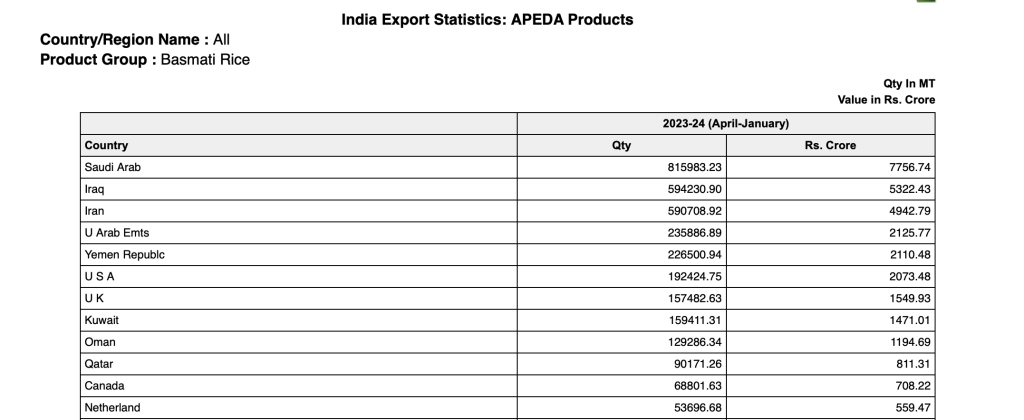
Exports increased to 4.68 MMT in April-February, from 4.1 MMT during the same period, rising 14% in volume
India, renowned for its aromatic and high-quality basmati rice, has witnessed a significant surge in exports despite facing various challenges in recent times. From overcoming logistical hurdles to navigating trade restrictions, India’s basmati rice industry has demonstrated resilience and adaptability. Let’s delve deeper into the trends and factors influencing this remarkable growth.
The Growth in Basmati Rice Exports:
Between April 2023 and February 2024, India experienced a remarkable 22 percent surge in exports of high-quality basmati rice, reaching a staggering $5.2 billion. This surge was primarily fueled by robust demand from key regions, particularly West Asia. In terms of volume, basmati rice exports increased by 14 percent, with shipments totaling 4.68 million metric tonnes (MMT) compared to 4.1 MMT in the corresponding period of the previous year.
According to the Agriculture Export Board, – Basmati rice worth of 37959 Crore was exported in last FY23-24

Counties exported to where: All West Asian markets were our top buyers for Basmati Rice.
The top 12 countries listed in the table imported a total of 3,841,386.89 MT of Basmati rice valued at Rs. 34,483.88 crore.

Challenges and Resilience:
Despite the impressive growth, the basmati rice industry in India faced several challenges. The imposition of a minimum export price (MEP) and logistical constraints at the Red Sea posed significant hurdles. Additionally, the government’s decision to ban the export of non-basmati white rice aimed at stabilizing domestic supply and controlling inflation added complexity to the export landscape. However, Indian exporters demonstrated resilience and adaptability in navigating these challenges.
While the exports for the entire fiscal year are projected to establish a new record once the figures for March are incorporated, concerns arise due to prevailing geopolitical tensions in the Middle East, which is a key market accounting for over 70 percent of basmati exports.
Impact of Trade Restrictions:
In July, the Indian government implemented a ban on the export of non-basmati white rice, followed by the imposition of a minimum export price on basmati rice a month later. These measures were aimed at preventing the mislabeling of non-basmati varieties as premium basmati rice and safeguarding the interests of domestic consumers. Despite initial concerns about potential market shifts towards Pakistani basmati rice, India’s exports remained unaffected.
Key Export Markets:
India’s basmati rice found favor in various international markets, with West Asia, the Gulf Cooperation Council (GCC), Europe, North America, and others emerging as key destinations. Despite challenges such as the Red Sea crisis impacting European exports, India continued to dominate its top export destinations, including Iran, Iraq, Saudi Arabia, the US, and the UAE.

Expansion of Export Destinations:
One notable trend was the expansion of export destinations for Indian basmati rice. Data compiled by the commerce department revealed a significant increase in the number of export destinations, growing from 140 to 149 during the April-December period compared to the previous year. This expansion underscores the growing global demand for India’s premium basmati rice.
Conclusion:
India’s basmati rice industry has showcased remarkable growth amidst challenges, driven by robust demand from key international markets. Despite trade restrictions and logistical hurdles, Indian exporters have demonstrated resilience and adaptability, maintaining their dominance in the global basmati rice trade. With an expanding export footprint and sustained demand, India’s basmati rice industry is poised for continued success on the world stage.
Looking for more understanding on Rice Trade, Check out: India-Singapore Rice Trade Faces Uncertainty Amidst Disagreements and Customs Issues
Do Follow us on Our Social Media channels to stay ahead in your rice business.
